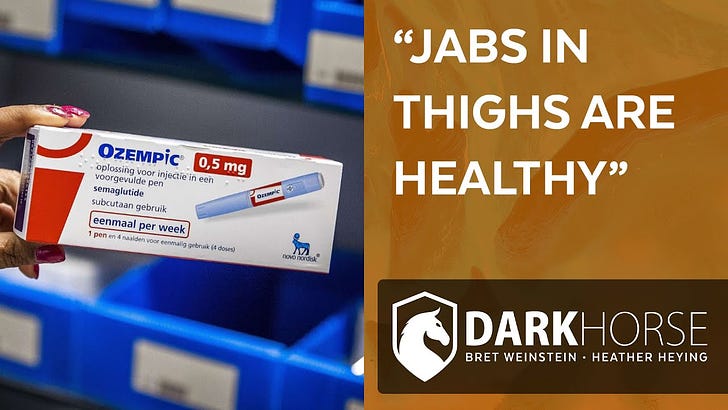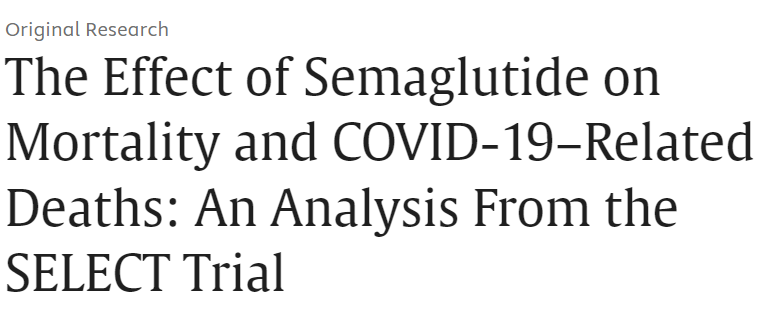Following along a myriad of alleged benefits, there are now claims suggesting that Wegovy- the highest dose of Semaglutide prescribable- can reduce the risk of COVID death as suggested by a recent study.1
The list of possible uses for these medications continues to grow, and with it should come growing concerns that everyone may be influenced or coerced to be on these medications for any reason whether it be for obesity, cardiovascular disease, diabetes, Alzheimer’s, cancer, addiction, etc.
Essentially, find any disease known to man and you’re likely to find a reason to prescribe these GLP-1 RAs for that disease. If you can pathologize any disease you can offer a treatment, and here it’s obvious that there’s a lot of money to be made in finding any possible use for these medications as they continue to be made out to be some sort of “miracle drug”.
Of course, when one considers these GLP-1 RAs within the context of COVID one must wonder what exact explanation there could be for such an effect to occur.
The new evidence stems from additional data analysis from Novo Nordisk’s SELECT clinical trial which evaluated the highest dose of Semaglutide as a risk reducer for major averse cardiovascular events (MACE).
The study was initially started during the pre-pandemic era in October 2018 and proceeded into the pandemic era of early 2020 – 2022. Because of this overlap with the pandemic researchers were able to evaluate another variable.
Among participants of the SELECT trial around ¼ of the participants were reported to have had a diagnosis of COVID. The diagnostic criteria don’t appear to be provided in the study, and references to diagnoses suggest “reports” of COVID.
The median time from randomization within the SELECT trial to a COVID diagnoses was around 2 years, with most reported cases occurring more than a year after trial randomization.
Interestingly, there didn’t appear to be an association between Semaglutide use and infection rates. Instead, there did appear to be an apparent association between Semaglutide use and COVID severity, as well as an apparent reduction in non-cardiovascular related deaths among Semaglutide users:
However, among patients who reported a diagnosis of COVID-19, fewer patients treated with semaglutide had serious COVID-19–related adverse events (232 [2.6%] vs 277 [3.1%]; P = 0.04).
[…]
Fewer deaths were adjudicated as directly related to COVID-19 in the semaglutide arm compared with the placebo arm (43 vs 65; HR: 0.66; 95% CI: 0.44-0.96) (Supplemental Figure 4). Similarly, the rate of all-cause death concurrent with COVID-19 serious adverse events was also lower in the semaglutide arm compared with the placebo arm (46 vs 69; HR: 0.66; 95% CI: 0.45-0.96).
Some of the information here is rather interesting, and it provides some additional context to my prior assessment of the SELECT trial.
Of note, what’s interesting is that among non-cardiovascular related deaths infection was one of the top explanations for participant death. This is a rather interesting finding given the overlap with the COVID pandemic. The relationship with the pandemic is made more likely given the increase in non-cardiovascular related deaths that occurred during the onset of the pandemic relative to timepoints prior to the pandemic.
Now, the information here gets rather jumbled as the authors flip between referring to non-cardiovascular related deaths and mentioning COVID infections and death, which can confuse readers.2 But bear in mind that COVID deaths would be a subcategory of non-CV death.
Nonetheless, the authors make an interesting inference when it comes to their findings, such that those who are not on Semaglutide may be more at risk of dying from COVID (and thus categorized as a non-CV death), resulting in a bias in which Semaglutide users were more likely to die from cardiovascular-related causes.
In essence, COVID was likely a “competing risk” relative to cardiovascular-related deaths, to the extent that a death related to COVID would likely precede a possible death from cardiovascular-related causes. Therefore, some people who were likely to die from cardiovascular-related deaths were shuffled into the “COVID deaths” group, resulting in a bias in which placebo users had a higher than expected death related to COVID while Semaglutide users had a higher than expected rate of cardiovascular-related events and deaths as the reduced risk of COVID death would inherently shuffle these individuals into the “CV-death” group.
The authors clarify this perspective in the following way:
The first observation is that non-CV death may have acted as a “competing risk” for CV death. Patients who reported a COVID-19 infection were more likely to die from non-CV causes, whereas patients without a COVID-19 event died, as expected in this population, predominantly from CV causes. The relatively high number of non-CV deaths in patients with COVID-19 combined with fewer non-CV deaths with semaglutide vs placebo meant that more patients in the semaglutide arm than in the placebo arm survived to remain “at risk” for CV death.
Now, when I covered the initial findings from the SELECT trial, I made mention of a strange trend in many of the plots, to the extent that there seemed to be a strange convergence in MACE including cardiovascular-related deaths that appeared to be resolved within the tail months of the trial.
I wasn’t sure why that was occurring at the time, and I raised some questions regarding what effect that strange convergence/divergence would have on the analysis of the results.
The obvious answer, and one that is elaborated in this current study, is the fact that the convergence was occurring during the pandemic period, and given the remarks from the author it appears to suggest that the COVID pandemic biased Semaglutide users towards having higher rates of MACE and CV-related deaths- since they didn’t die from COVID they were still at risk for these events happening, thus leading to a shuffling which participants:
In the SELECT trial, the competing risk of non-CV death (which prevents the occurrence of CV death) combined with the lower rates of non-CV death in the semaglutide arm may have resulted in the unanticipated convergence of survival curves for CV death observed during the COVID-19 pandemic.
This at least helps to explain some of the weird trends in the SELECT study, but in doing so I don’t think it puts the SELECT trial in a good position, as it would emphasize the fact that the SELECT trial was heavily confounded by the pandemic. Put another way, any comparison of cardiovascular-related deaths between the Semaglutide group and the placebo group would likely be inaccurate as many of these participants may have died prior to a possible CV-death.
This doesn’t mean that Semaglutide would perform better or worse if the pandemic didn’t happen- it would just suggest that the data from the SELECT trial should be considered with greater hesitancy given that the pandemic seems to have played a big role in some of the results.
It’s [likely] about the weight
Now, the interpretations for this new study have led to even greater praise of these medications, suggesting a new utility for these drugs and a new reason that people should be taking them as highlighted in an excerpt from CNBC News:
The discovery of new benefits from semaglutide could open up the drug for further uses.
Discussing the Friday papers, Yale University School of Medicine Professor and JACC editor Harlan Krumholz said in a JACC interview, “I begin to think about the weight loss almost as a side effect, I mean these [drugs] are really promoting health.”
He added, “I was thinking mostly about cardiometabolic health… but there may be many mechanisms by which [semaglutide] is making us healthier, and in some ways this is suggesting it’s helping us to resist the adverse consequences of the pandemic.”
An even more egregious assertion was made in an editorial in response to the study’s findings,3 in which Semaglutide was being compared to vaccines in their preventative utilities against infections (emphasis mine):
People with coronary artery disease who had fatal myocardial infarctions precipitated by the physiological stress/inflammatory response induced by COVID-19 (or any infection) could have averted those outcomes were their risk profiles lower when infected. The present study implies that, in just a short period, semaglutide was adequate to reduce SARS-CoV-2 mortality. This is akin to a vaccine against the indirect effects of a pathogen, except here, we would expect the efficacy to augment over time, rather than wane. Moreover, the benefit could apply to many infections, not just SARS-CoV-2.
Many readers should not be so easily fooled by such comments of these weird, obscure mechanisms by which these medications are helping to reduce risk of severe COVID and death. They certainly should hesitate when it comes to this correlation between these medications and vaccines.
Because by all accounts a far easier explanation is provided for these findings, and one even emphasized by the authors themselves.
That is, a likely explanation for these findings is due to losing weight.
Throughout the pandemic there has been great emphasis in pointing out that obesity puts one at greater risk of severe COVID and greater risk of death. After all, obesity is objectively unhealthy irrespective of what fat activists may claim.
And this claim isn’t controversial- it’s been documented extensively in papers,4,5,6 and the CDC even has a page dedicated to pointing out that obesity worsens COVID outcomes.
This makes the events that transpired over COVID all the more contradictory, as lockdowns led to the unfortunate increase in obesity among many individuals including children.7 If only everyone was prescribed Semaglutide along with their lockdowns.8
Overall, wouldn’t it make sense that a drug that reduces your weight would also reduce your risk of being harmed by COVID?
The authors end their paper with the following paragraph, which points to the possibility that the lost weight in Semaglutide users may be one reason for the reduced COVID mortality:
Weight reduction reduces inflammation, as reflected by the lower levels of high-sensitivity C-reactive protein in patients treated with semaglutide compared to placebo. Whether this is through reductions in visceral (especially epicardial or pericardial) adiposity30 or other pathways is not known. Other direct effects of Glucagon-like peptide-1 receptor agonism are also possible. A matched cohort study of patients who underwent surgical bariatric surgery found that substantial weight loss was associated with lower rates of more severe COVID-19 complications.31 Accordingly, it is plausible that the decreased risk of infectious deaths is caused by weight loss, which was 5 kg greater in patients assigned to semaglutide compared to placebo by 1 year, the average time to COVID-19 diagnosis after randomization.
The authors point out some reservations in other explanations, including the idea that improved cardiometabolic parameters could possibly explain the reduced COVID mortality given that these parameters did not improve to such a degree to explain the reduced incidences of MACE.
And there are some other explanations worth considering, such as the fact that native GLP-1 appears to have anti-inflammatory and immunomodulating properties.9,10
However, when considering what the average individual can do for themselves to improve their health the answer doesn’t need to become overly complicated. You don’t have to consider unknown mechanisms or some ridiculous vaccine allegory to understand the rudimentary principle that losing weight would help alleviate many of the maladies affecting us.
Many of these GLP-1 proponents will use these findings as if to suggest that the best way to prevent infections is to give Ozempic or Wegovy, rather than just losing the weight and maintaining a healthy BMI. This is one of the growing dangers when it comes to these medications- it removes personal responsibility and autonomy and puts it in the hands of pharma. It enforces a reliance on medications for things that you should strive for on your own.
Don’t fall for fads, and don’t fall for science tomfoolery that tries to complicate matters.
A few months ago Bret and Heather had a conversation regarding the SELECT trial and some of their thoughts regarding these drugs. I didn’t find the discussion regarding the actual study too compelling as there was a lot that was not discussed. However, I found the commentary rather interesting, and they put into words the thoughts that I have albeit in a more concise way.
If you enjoyed this post and other works please consider supporting me through a paid Substack subscription or through my Ko-fi. Any bit helps, and it encourages independent creators and journalists such as myself to provide work outside of the mainstream narrative.

Scirica, B. M., Lincoff, A. M., Lingvay, I., Bogdanski, P., Buscemi, S., Colhoun, H., Craciun, A. E., Ezhov, M., Hardt-Lindberg, S., Kleist Jeppesen, O., Matos, A. L. S. A., Node, K., Schiele, F., Toplak, H., van Beek, A., Weeke, P. E., Wiviott, S. D., Deanfield, J., & Ryan, D. (2024). The Effect of Semaglutide on Mortality and COVID-19-Related Deaths: An Analysis From the SELECT Trial. Journal of the American College of Cardiology, S0735-1097(24)08156-7. Advance online publication. https://doi.org/10.1016/j.jacc.2024.08.007
It also doesn’t help that CV is the abbreviation for “cardiovascular” and not “COVID”. It’s hard not to read non-CV as “non-COVID”…
Faust J. S. (2024). Semaglutide, COVID-19 Mortality, and the Power of Harnessing Ongoing Clinical Trials During Unexpected Outbreaks. Journal of the American College of Cardiology, S0735-1097(24)08246-9. Advance online publication. https://doi.org/10.1016/j.jacc.2024.08.035
Yang, Y., Song, Y., & Hou, D. (2023). Obesity and COVID-19 Pandemics: Epidemiology, Mechanisms, and Management. Diabetes, metabolic syndrome and obesity : targets and therapy, 16, 4147–4156. https://doi.org/10.2147/DMSO.S441762
Russo, A., Pisaturo, M., Zollo, V., Martini, S., Maggi, P., Numis, F. G., Gentile, I., Sangiovanni, N., Rossomando, A. M., Bianco, V., Calabria, G., Pisapia, R., Codella, A. V., Masullo, A., Manzillo, E., Russo, G., Parrella, R., Dell'Aquila, G., Gambardella, M., Ponticiello, A., … CoviCam Group (2023). Obesity as a Risk Factor of Severe Outcome of COVID-19: A Pair-Matched 1:2 Case-Control Study. Journal of clinical medicine, 12(12), 4055. https://doi.org/10.3390/jcm12124055
Arulanandam, B., Beladi, H. & Chakrabarti, A. Obesity and COVID-19 mortality are correlated. Sci Rep 13, 5895 (2023). https://doi.org/10.1038/s41598-023-33093-3
Brian P. Jenssen, Mary Kate Kelly, Maura Powell, Zoe Bouchelle, Stephanie L. Mayne, Alexander G. Fiks; COVID-19 and Changes in Child Obesity. Pediatrics May 2021; 147 (5): e2021050123. 10.1542/peds.2021-050123
Think about this tagline: “Two weeks to flatten THE curve, and two weeks to flatten YOUR curve!”…
Mehdi, S. F., Pusapati, S., Anwar, M. S., Lohana, D., Kumar, P., Nandula, S. A., Nawaz, F. K., Tracey, K., Yang, H., LeRoith, D., Brownstein, M. J., & Roth, J. (2023). Glucagon-like peptide-1: a multi-faceted anti-inflammatory agent. Frontiers in immunology, 14, 1148209. https://doi.org/10.3389/fimmu.2023.1148209
Chen, J., Mei, A., Wei, Y., Li, C., Qian, H., Min, X., Yang, H., Dong, L., Rao, X., & Zhong, J. (2022). GLP-1 receptor agonist as a modulator of innate immunity. Frontiers in immunology, 13, 997578. https://doi.org/10.3389/fimmu.2022.997578






